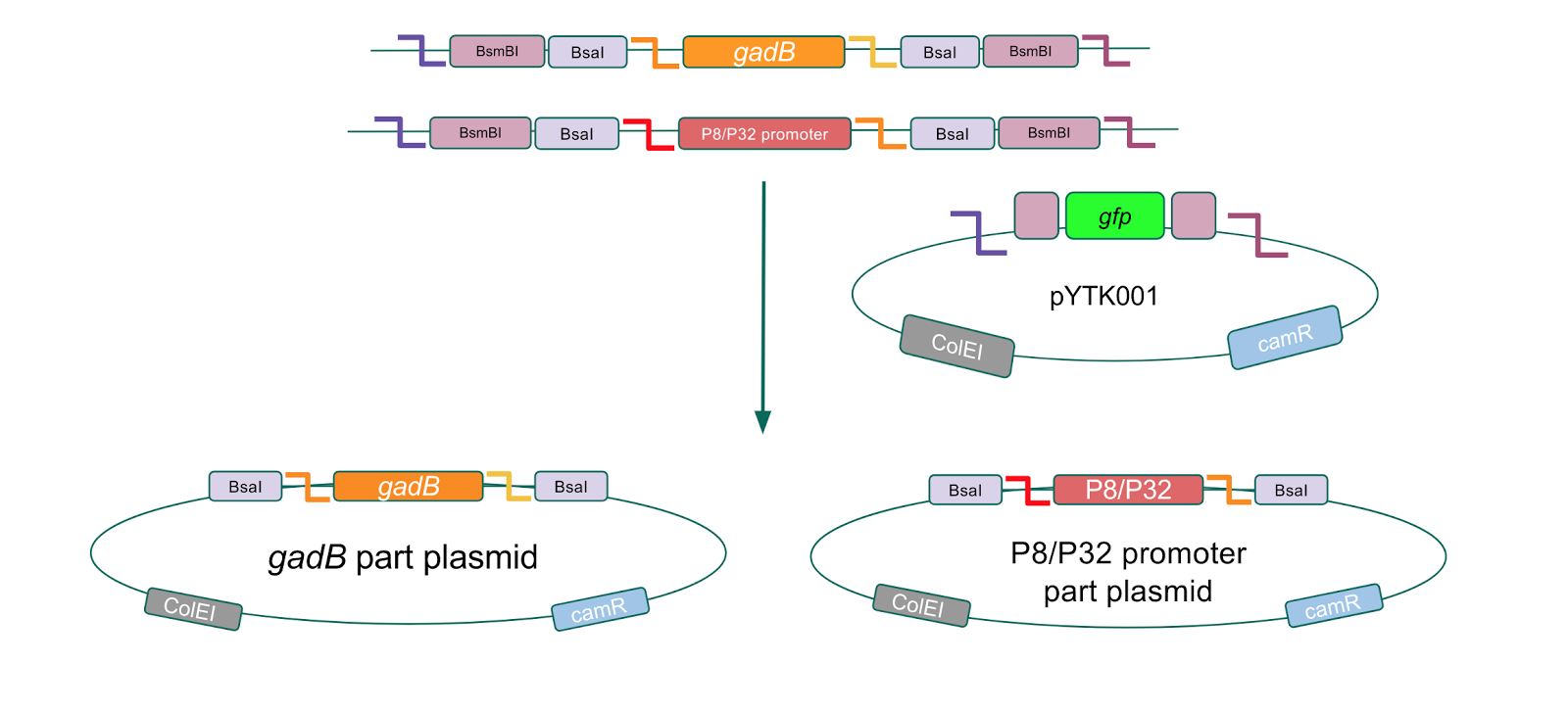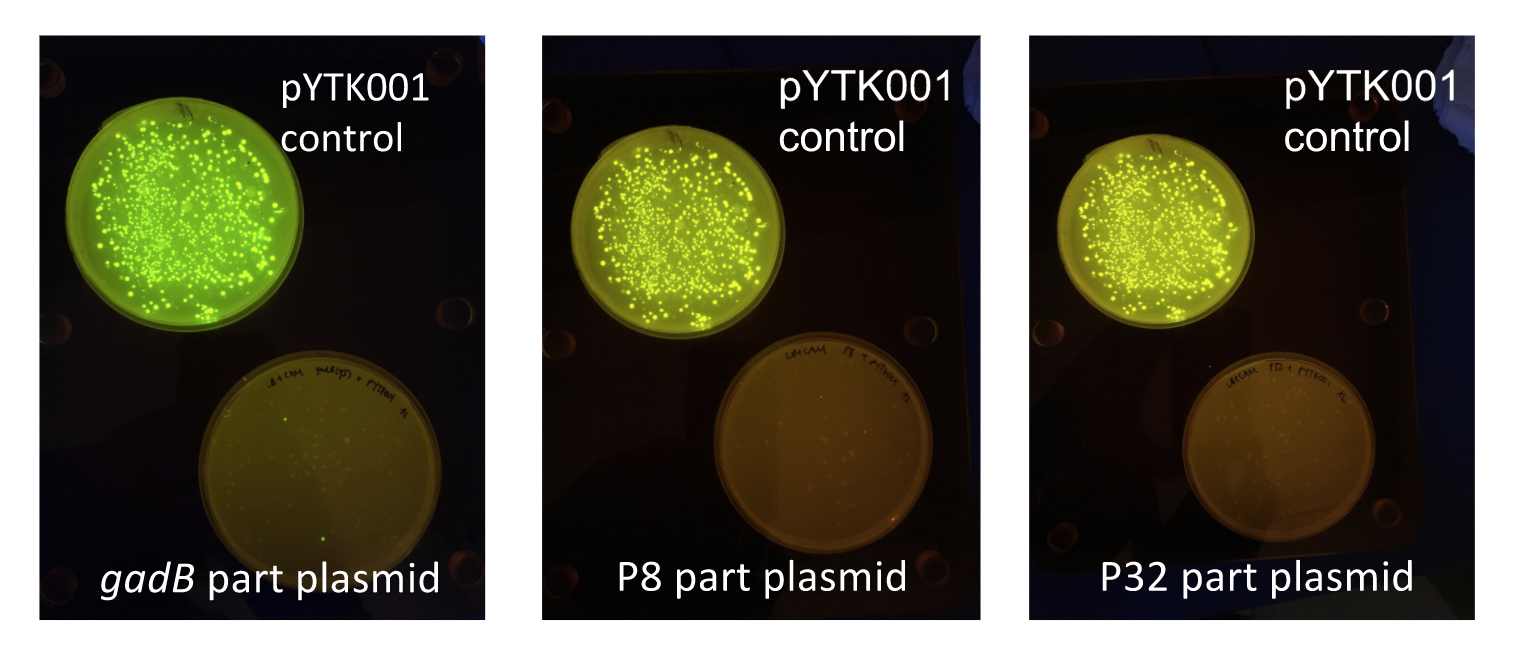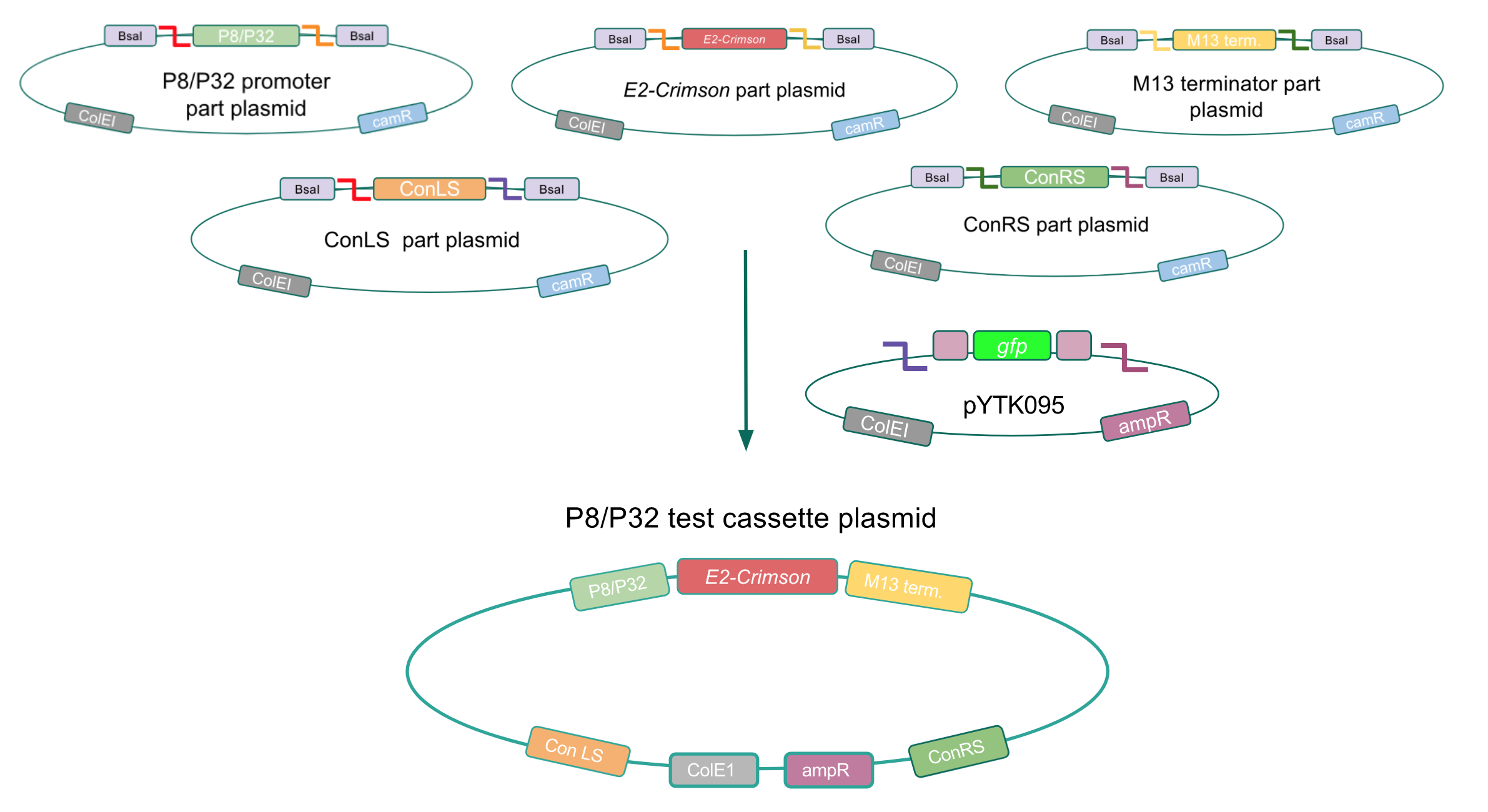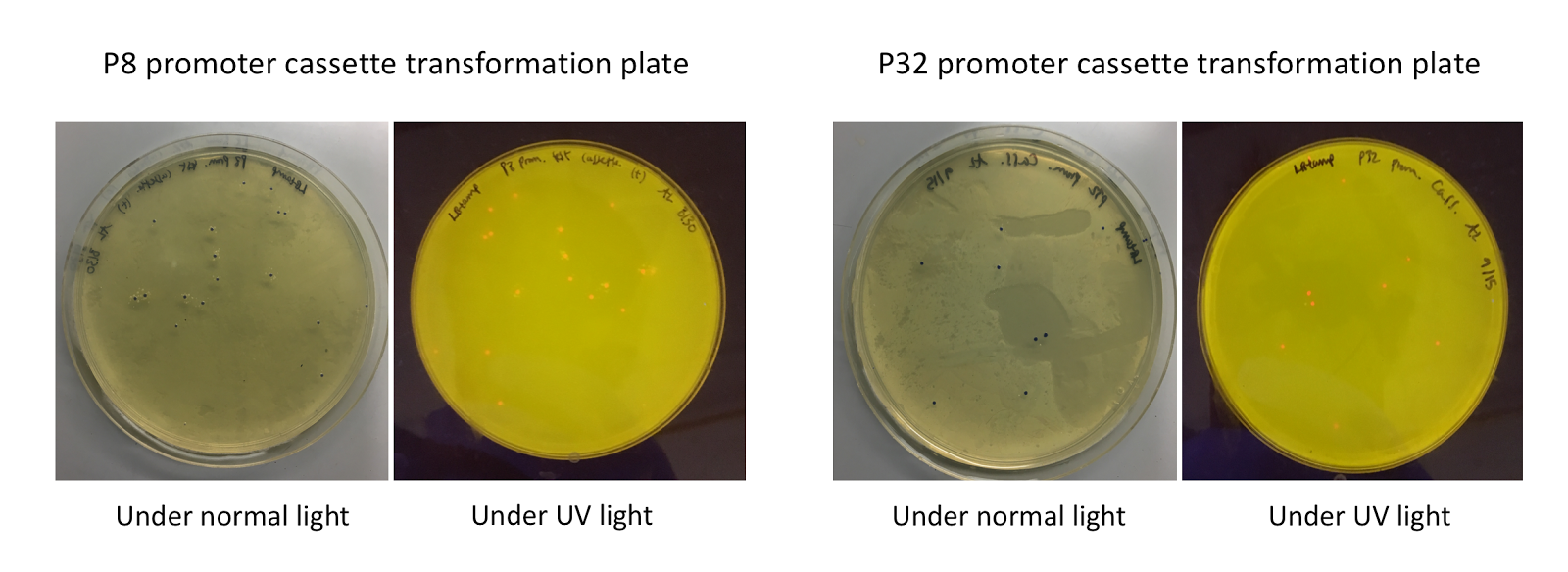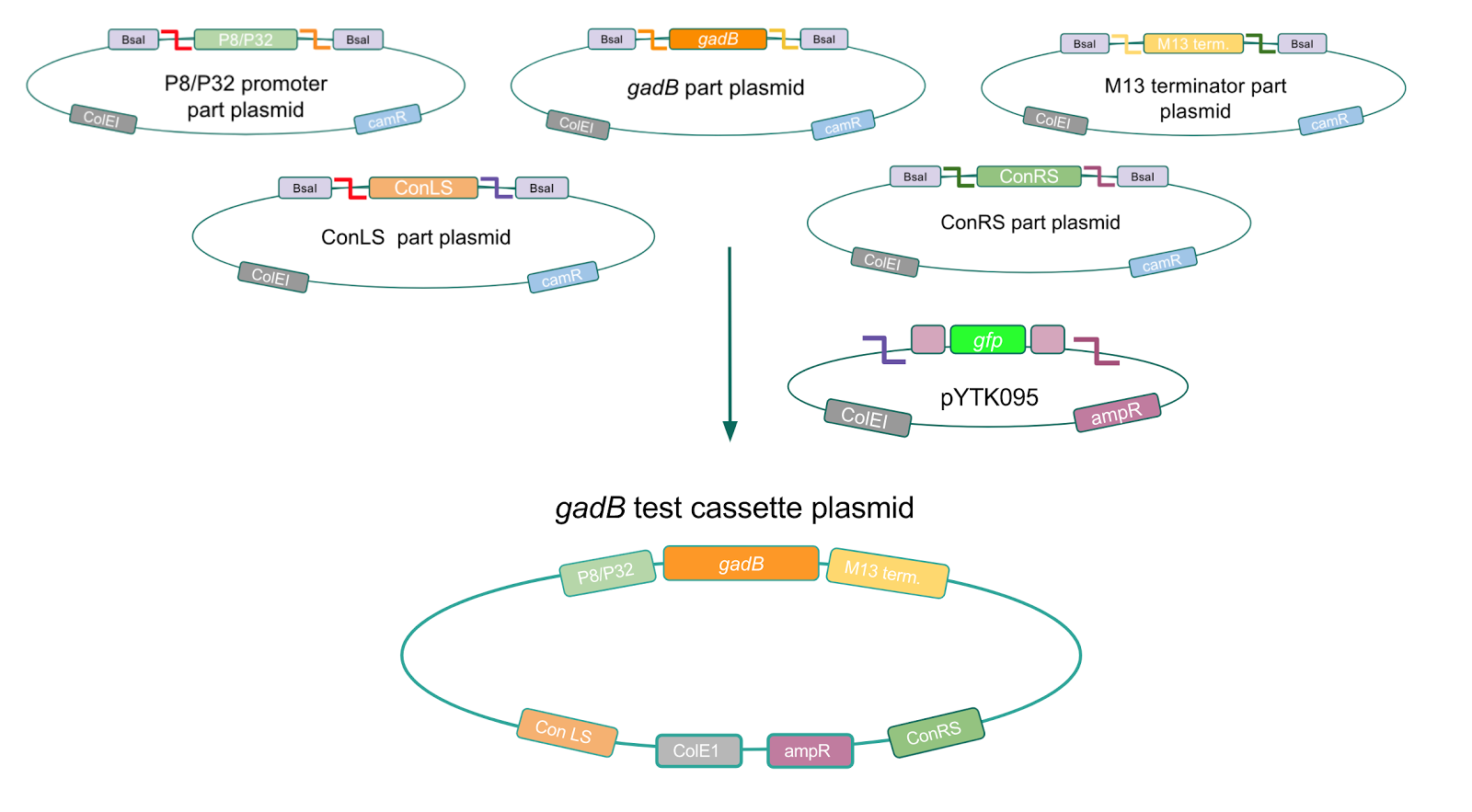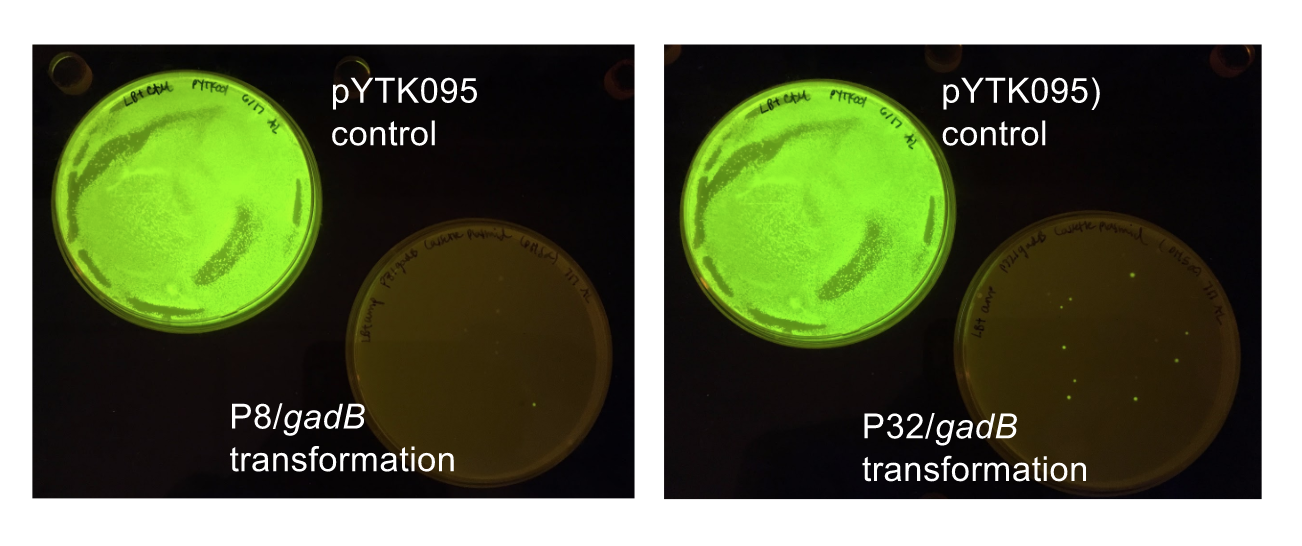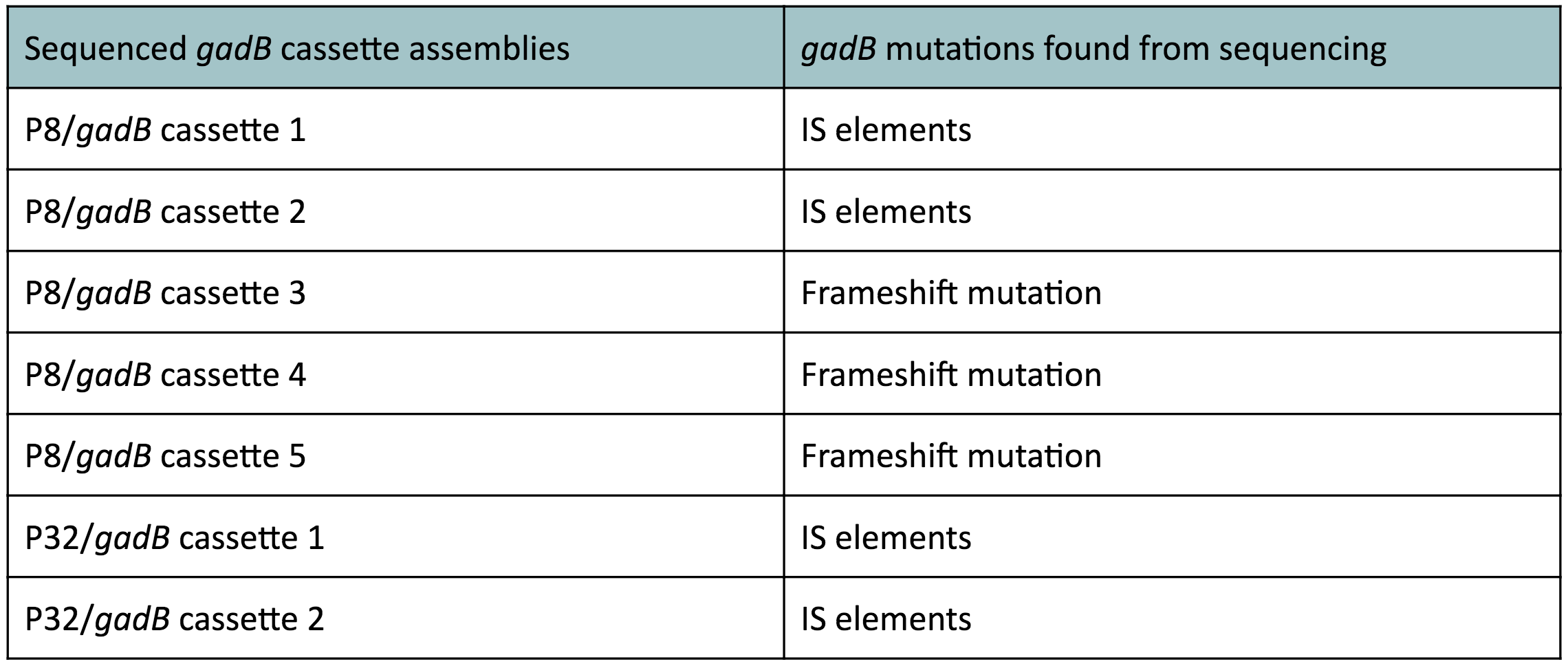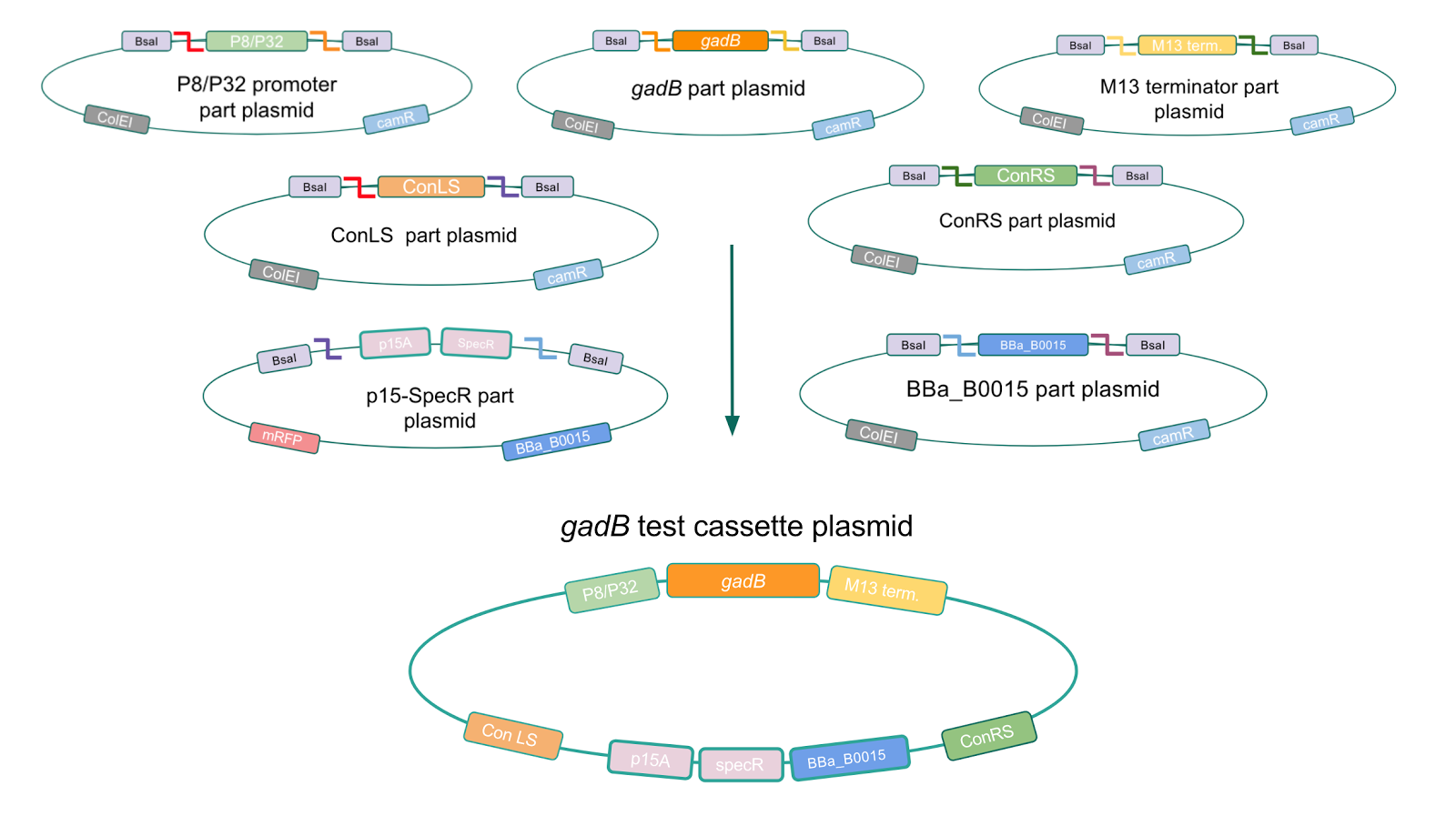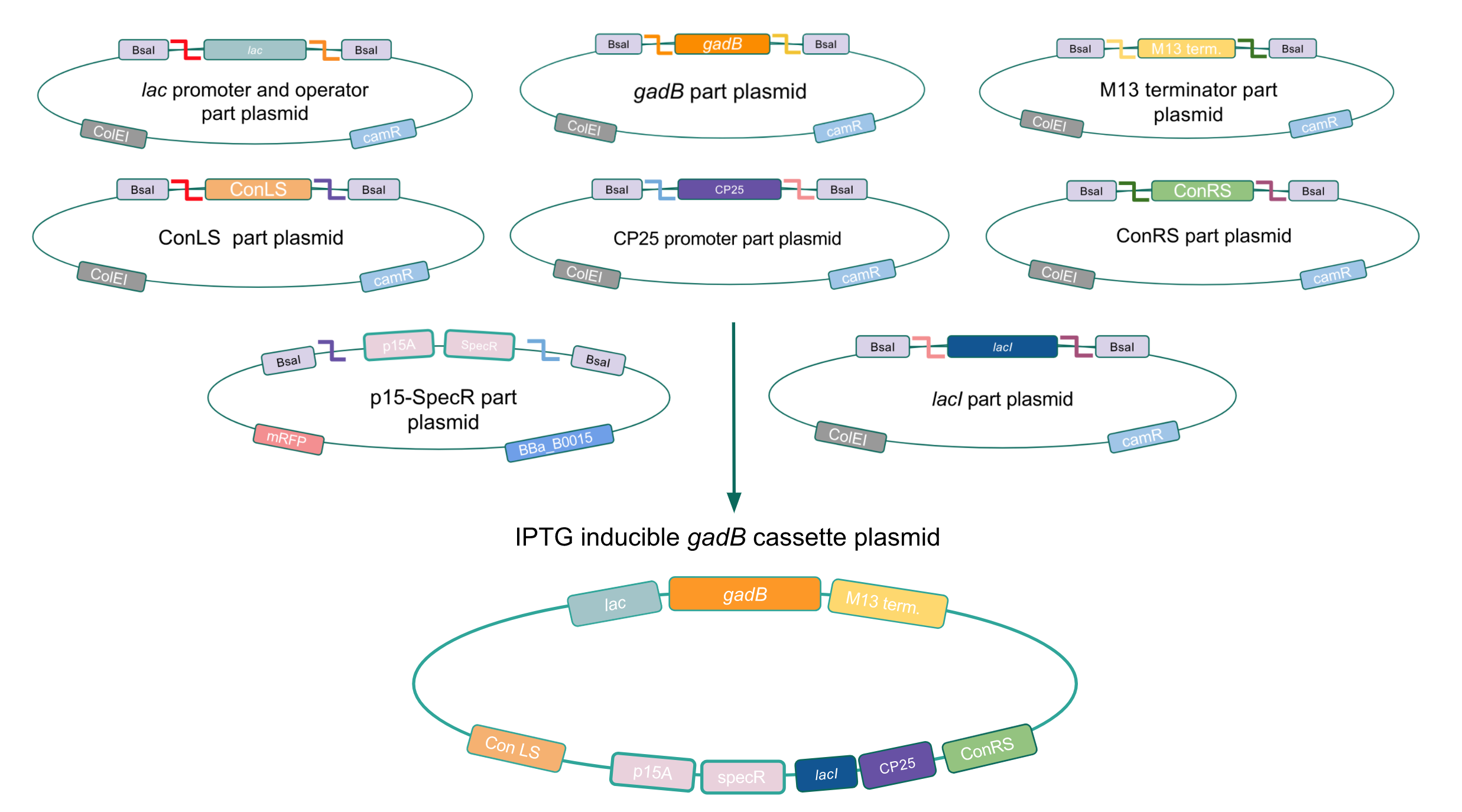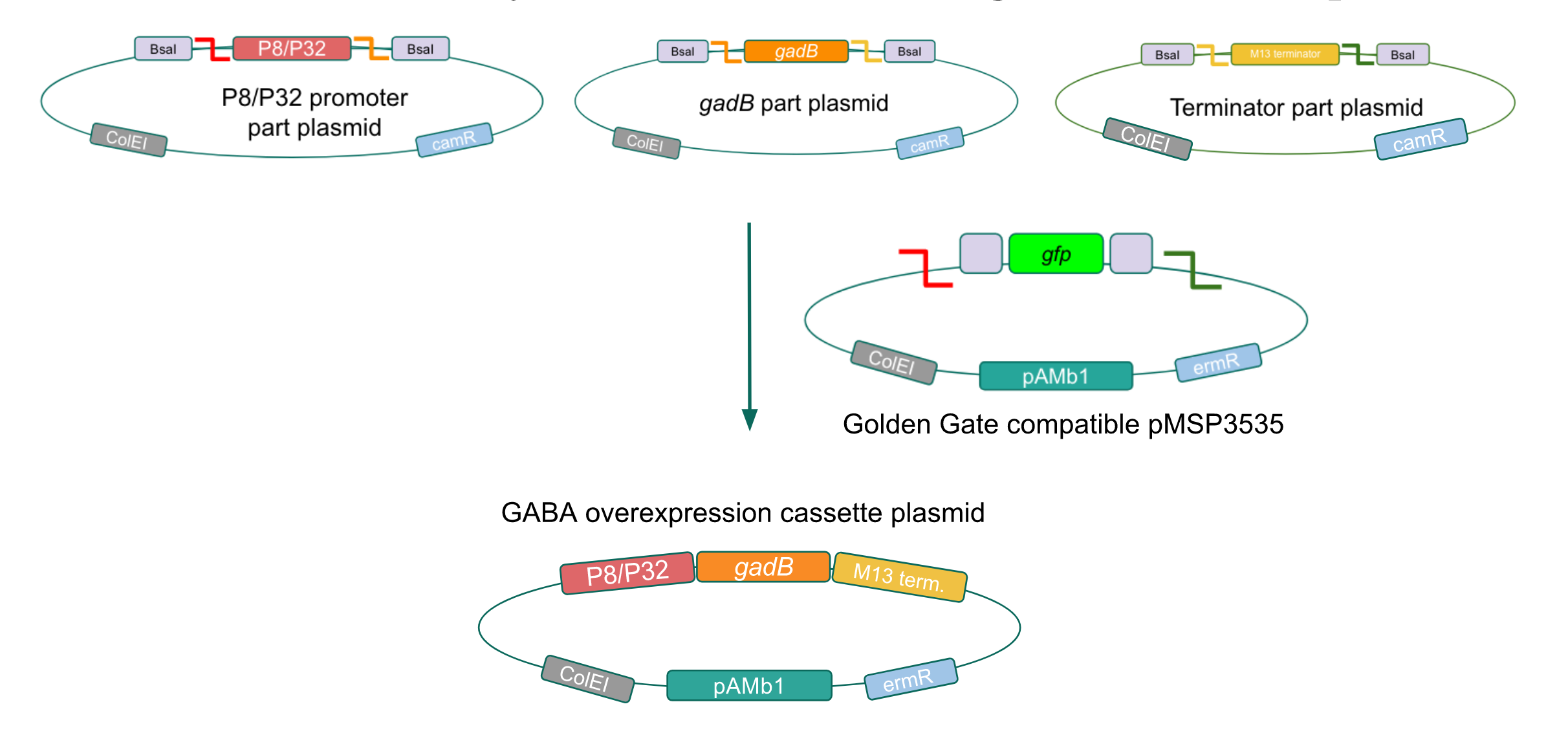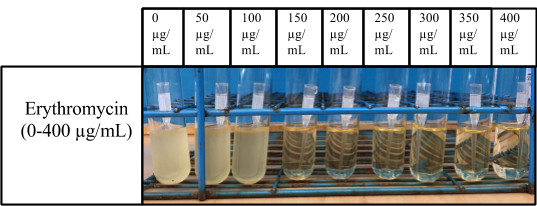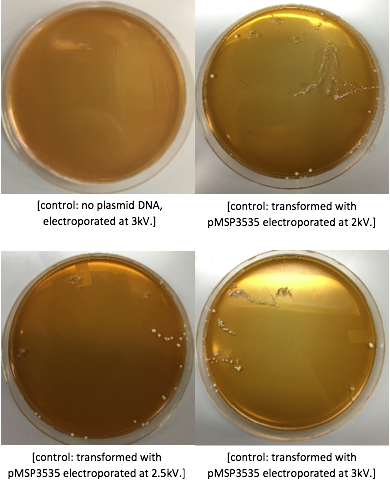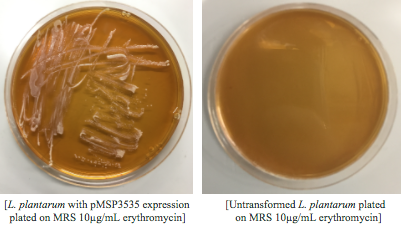| Line 1: | Line 1: | ||
{{Austin_UTexas}} | {{Austin_UTexas}} | ||
| − | |||
| − | |||
<html> | <html> | ||
| + | <head> | ||
| + | <style> | ||
| + | body { | ||
| + | background-color: #282828 | ||
| − | + | } | |
| − | + | </style> | |
| − | + | </head> | |
| − | + | <div class="column full_size"> | |
| + | <div style="background-color: lightcyan;padding:14px; font-family: verdana"> | ||
| − | + | <br> | |
| − | + | ||
| − | + | ||
| − | + | ||
| − | + | <div class="clear"></div> | |
| − | + | ||
| − | + | ||
| − | + | ||
| − | + | ||
| − | + | ||
| − | + | ||
| − | + | ||
| − | + | ||
| − | + | ||
| − | + | ||
| − | + | ||
| − | + | ||
| − | + | ||
| − | + | ||
| − | |||
<style> | <style> | ||
div.naviSection { | div.naviSection { | ||
| Line 43: | Line 28: | ||
width: 100%; | width: 100%; | ||
border: none; | border: none; | ||
| − | text-align: | + | text-align: justify; |
outline: none; | outline: none; | ||
font-size: 15px; | font-size: 15px; | ||
| Line 56: | Line 41: | ||
padding: 0 18px; | padding: 0 18px; | ||
display: none; | display: none; | ||
| − | background-color: | + | background-color: gray; |
} | } | ||
body { | body { | ||
| Line 64: | Line 49: | ||
</style> | </style> | ||
| − | |||
<div class = "column_full_size_inner"> | <div class = "column_full_size_inner"> | ||
| + | <h2 style="font-family: verdana; font-size: 45px; text-align: center; color: rgb(0, 184, 230)">Results</h2> | ||
<div class="clear"></div> | <div class="clear"></div> | ||
| − | |||
<div class="clear"></div> | <div class="clear"></div> | ||
| Line 81: | Line 65: | ||
</div> | </div> | ||
| − | <div class="column | + | <div class="column fifth_size"> |
| − | <a href="#section3"><img src="https://static.igem.org/mediawiki/2017/e/ | + | <a href="#section3"><img src="https://static.igem.org/mediawiki/2017/archive/e/e7/20171101072448%21GABAFinal.png" style="width:100%"> <p>GABA Production </p></a> |
</div> | </div> | ||
<div class="column sixth_size"> | <div class="column sixth_size"> | ||
| − | <a href="#section4"><img src="https://static.igem.org/mediawiki/2017/ | + | <a href="#section4"><img src="https://static.igem.org/mediawiki/2017/e/e5/Lacto-final.png" style="width:100%"><p><i>Lactobacillus plantarum</i></p></a> |
</div> | </div> | ||
| − | < | + | <strong><h2 style="font-family: verdana; font-size: 17px; text-align: center; color: darkcyan">Click on one of the images above to learn more about our results!</h2></strong> |
<br> | <br> | ||
| Line 98: | Line 82: | ||
<div class="column full_size"> | <div class="column full_size"> | ||
| − | < | + | <p style="font-family: verdana">Although bacteria can naturally synthesize GABA, we wanted to <b>increase expression of the <i>gadB</i> gene and subsequently GABA production in order to imbue our probiotic with a more potent medicinal quality</b>, with the idea that this GABA-overproducing probiotic can then be consumed by patients with bowel disorders or anxiety (1). Overexpression of the <i>gadB</i> gene will be accomplished by placing it under the control of either the P8 or P32 constitutive promoters from <i>Lactococcus lactis</i> (2). |
| − | + | ||
| − | <p | + | <p style="font-family: verdana">To make our GABA-producing probiotic we first needed to assemble a GABA overexpression cassette plasmid using the Golden Gate assembly method.</b> The intention here is that bacteria containing this GABA overexpression cassette plasmid should produce high levels of GABA. In short, Golden Gate Assembly is a new cloning method that allows for the creation of a multi-part DNA assembly (i.e. cassette plasmid) in a single reaction through the use of DNA parts containing specific, predefined suffixes and prefixes with recognition sites for Type IIs restriction enzymes (e.g. BsmBI and BsaI). The specificity of these suffixes and prefixes provides directionality of the desired DNA parts during the assembly process. For our purposes, we used the MoClo Yeast Tool Kit developed by John Dueber (3).</p> |
| − | |||
| − | |||
| − | |||
<br> | <br> | ||
<div class="naviSection" id="section1"> | <div class="naviSection" id="section1"> | ||
| + | |||
<br> | <br> | ||
| − | + | ||
| − | + | <h2 style="font-family: verdana; font-size: 30px; text-align: center">Part Assembly</h2> | |
| − | <h2 style="font-family: verdana; font-size: 30px">Part Assembly</h2> | + | |
<br> | <br> | ||
| Line 118: | Line 98: | ||
<p style="font-family: verdana">The first part of our Golden Gate assembly workflow was part assembly, in which the <i>gadB</i> gene and the P8/P32 promoters were individually cloned into the entry vector pYTK001 <b>(Fig. 1)</b>. The <i>gadB</i> gene and P8/P32 promoter sequences contain flanking BsmBI sites that produce overhangs compatible with those cut by BsmBI in the entry vector pYTK001. Thus, BsmBI cloning should result in part plasmids containing the <i>gadB</i> gene and P8/P32 promoters set within the pYTK001 backbone. </p> | <p style="font-family: verdana">The first part of our Golden Gate assembly workflow was part assembly, in which the <i>gadB</i> gene and the P8/P32 promoters were individually cloned into the entry vector pYTK001 <b>(Fig. 1)</b>. The <i>gadB</i> gene and P8/P32 promoter sequences contain flanking BsmBI sites that produce overhangs compatible with those cut by BsmBI in the entry vector pYTK001. Thus, BsmBI cloning should result in part plasmids containing the <i>gadB</i> gene and P8/P32 promoters set within the pYTK001 backbone. </p> | ||
| − | |||
<br> | <br> | ||
| Line 124: | Line 103: | ||
[[File:T--Austin_UTexas--gadBAndPromoterPartPlasmids.jpg|thumb|center|800px|<b>Figure 1.</b> <i>gadB</i> gene and P8/P32 promoter part assembly process. Golden Gate compatible <i>gadB</i> and P8/P32 promoter sequences are cloned into the pYTK001 entry vector via BsmBI assembly.]] | [[File:T--Austin_UTexas--gadBAndPromoterPartPlasmids.jpg|thumb|center|800px|<b>Figure 1.</b> <i>gadB</i> gene and P8/P32 promoter part assembly process. Golden Gate compatible <i>gadB</i> and P8/P32 promoter sequences are cloned into the pYTK001 entry vector via BsmBI assembly.]] | ||
<html> | <html> | ||
| − | |||
| − | |||
<br> | <br> | ||
<p style="font-family: verdana">Additionally, the BsmBI sites and overhangs in pYTK001 are flanking a <i>gfp</i> reporter gene. During the part assembly process, our DNA sequences of interest replaced this <i>gfp</i> reporter gene. This provided a phenotypic screen that allowed us to visually see which transformant colonies were negative and potentially positive. <b>Under UV illumination, positive colonies containing our intended part plasmid assembly did not exhibit fluorescence under the UV illumination, while negative colonies did (Fig. 2)</b>. The non-fluorescent colonies on the part plasmid transformation plates were miniprepped and subsequently sequence verified.</p> | <p style="font-family: verdana">Additionally, the BsmBI sites and overhangs in pYTK001 are flanking a <i>gfp</i> reporter gene. During the part assembly process, our DNA sequences of interest replaced this <i>gfp</i> reporter gene. This provided a phenotypic screen that allowed us to visually see which transformant colonies were negative and potentially positive. <b>Under UV illumination, positive colonies containing our intended part plasmid assembly did not exhibit fluorescence under the UV illumination, while negative colonies did (Fig. 2)</b>. The non-fluorescent colonies on the part plasmid transformation plates were miniprepped and subsequently sequence verified.</p> | ||
| − | |||
<br> | <br> | ||
| Line 139: | Line 115: | ||
<br> | <br> | ||
| − | + | ||
<a href="#top"><p>Back to Top</p></a> | <a href="#top"><p>Back to Top</p></a> | ||
</div> | </div> | ||
<div class="naviSection" id="section2"> | <div class="naviSection" id="section2"> | ||
| − | |||
| − | |||
| − | |||
<br> | <br> | ||
| + | |||
| + | <h2 style="font-family: verdana; font-size: 30px; text-align: center">Testing constitutive <i>Lactococcal</i> promoters </h2> | ||
| + | <p style="font-family: verdana"><b>After successfully creating the <i>gadB</i> gene and P8/P32 promoter part plasmids, the functionality of these part plasmids were then assessed by assembling them into cassette plasmids.</b></p> | ||
| + | |||
<br> | <br> | ||
<p style="font-family: verdana">To test if our <i>Lactococcus lactis</i> constitutive promoters function well within <i>E. coli</i>, we created test cassette plasmids containing the <i>E2-Crimson</i> reporter gene (which encodes a red fluorescent protein) inserted downstream of either the P8 or P32 promoters using BsaI Golden Gate assembly. To create these test cassettes, we used the P8/P32 promoter part plasmids, the <i>E2-Crimson</i> part plasmid, an M13 terminator part plasmid, connector part plasmids, and the pYTK095 vector as the backbone <b>(Fig. 3).</b> <b>If the P8 and P32 promoters are functional in <i>E. coli</i>, we expected to observe red fluorescence in colonies transformed with our test cassette plasmids.</b></p> | <p style="font-family: verdana">To test if our <i>Lactococcus lactis</i> constitutive promoters function well within <i>E. coli</i>, we created test cassette plasmids containing the <i>E2-Crimson</i> reporter gene (which encodes a red fluorescent protein) inserted downstream of either the P8 or P32 promoters using BsaI Golden Gate assembly. To create these test cassettes, we used the P8/P32 promoter part plasmids, the <i>E2-Crimson</i> part plasmid, an M13 terminator part plasmid, connector part plasmids, and the pYTK095 vector as the backbone <b>(Fig. 3).</b> <b>If the P8 and P32 promoters are functional in <i>E. coli</i>, we expected to observe red fluorescence in colonies transformed with our test cassette plasmids.</b></p> | ||
| − | |||
<br> | <br> | ||
| Line 160: | Line 136: | ||
<html> | <html> | ||
| − | |||
<br> | <br> | ||
| Line 173: | Line 148: | ||
<br> | <br> | ||
| − | + | ||
<a href="#top"><p>Back to Top</p></a> | <a href="#top"><p>Back to Top</p></a> | ||
</div> | </div> | ||
<div class="naviSection" id="section3"> | <div class="naviSection" id="section3"> | ||
| − | |||
| − | |||
| − | |||
<br> | <br> | ||
| + | |||
| + | <h2 style="font-family: verdana; font-size: 30px; text-align: center">Testing for <i>gadB</i> overexpression in <i>E. coli</i></h2> | ||
| + | <p style="font-family: verdana"><b>Using Golden Gate Assembly, we created cassette plasmids to test if the <i>gadB</i> gene could be overexpressed in <i>E. coli</i> via the P8 and P32 promoters. </b> These cassette plasmids contained the <i>gadB</i> gene inserted downstream of either the P8 or P32 promoters. To make our <i>gadB</i> test cassette plasmids, we used pYTK095 as our backbone and part plasmids containing the P8/P32 promoters, <i>gadB</i> gene, M13 terminator, and connector sequences <b>(Fig. 5).</b></p> | ||
| + | |||
<br> | <br> | ||
| Line 193: | Line 169: | ||
<br> | <br> | ||
| − | <p>Similar to the pYTK001 entry vector in part assembly, the pYTK095 backbone used for cassette assembly contained a <i>gfp</i> reporter gene that is replaced by sequences of interest. This allowed us to easily perform a phenotypic screen for positive colonies. <b>Non-fluorescent colonies may potentially have had the correct cassette assembly, while fluorescent colonies did not (Fig. 6).</b></p> | + | <p style="font-family: verdana">Similar to the pYTK001 entry vector in part assembly, the pYTK095 backbone used for cassette assembly contained a <i>gfp</i> reporter gene that is replaced by sequences of interest. This allowed us to easily perform a phenotypic screen for positive colonies. <b>Non-fluorescent colonies may potentially have had the correct cassette assembly, while fluorescent colonies did not (Fig. 6).</b></p> |
| Line 202: | Line 178: | ||
| − | <p>The non-fluorescent colonies were then screened using colony PCR, and positive colonies were then miniprepped and sequenced. <b>The sequencing results indicated that there were several mutations within the <i>gadB</i> gene in the samples.</b> These mutations are recorded in <b>Table 1.</b></p> | + | <p style="font-family: verdana">The non-fluorescent colonies were then screened using colony PCR, and positive colonies were then miniprepped and sequenced. <b>The sequencing results indicated that there were several mutations within the <i>gadB</i> gene in the samples.</b> These mutations are recorded in <b>Table 1.</b></p> |
| Line 209: | Line 185: | ||
<html> | <html> | ||
| − | |||
<br> | <br> | ||
| − | <p>Along with being one of the canonical amino acids utilized in protein synthesis, glutamate plays an important role as the main amino-group donor in the biosynthesis of nitrogen-containing compounds such as amino acids and nucleotides (4, 5). Thus, we hypothesized that <i>gadB</i> overexpression via the P8 and P32 constitutive promoters and the high-copy | + | <p style="font-family: verdana">Along with being one of the canonical amino acids utilized in protein synthesis, glutamate plays an important role as the main amino-group donor in the biosynthesis of nitrogen-containing compounds such as amino acids and nucleotides (4, 5). Thus, we hypothesized that <i>gadB</i> overexpression via the P8 and P32 constitutive promoters and the high-copy number ColE1 origin induced a high metabolic load on the cells by shunting away glutamate from essential anabolic pathways. We believed that transformants containing the mutationally degraded <i>gadB</i> gene were selected for. In contrast, transformants containing the functional <i>gadB</i> gene were selected against due to having a depletion of glutamate substrates needed for important cellular processes. </p> |
| − | |||
<br> | <br> | ||
| − | <p><b>To troubleshoot this problem, we decided to use a backbone containing the low-copy number p15A origin for the cassette assembly (Fig. 7).</b></p> | + | <p style="font-family: verdana"><b>To troubleshoot this problem, we decided to use a backbone containing the low-copy number p15A origin for the cassette assembly (Fig. 7).</b></p> |
| Line 226: | Line 200: | ||
| − | <p>Copy number reduction of our <i>gadB</i> overexpression cassette plasmids (accomplished by replacing the ColE1 origin with the p15A origin) was expected to decrease the overall amount of <i>gadB</i> expression, thereby decreasing the metabolic load imposed on the cells and the mutation rates observed in the <i>gadB</i> gene. <b>However, we also observed several mutations within the <i>gadB</i> gene in the potentially positive cassette plasmids sequenced.</b> The observed mutations are detailed in Table 2.</p> | + | <p style="font-family: verdana">Copy number reduction of our <i>gadB</i> overexpression cassette plasmids (accomplished by replacing the ColE1 origin with the p15A origin) was expected to decrease the overall amount of <i>gadB</i> expression, thereby decreasing the metabolic load imposed on the cells and the mutation rates observed in the <i>gadB</i> gene. <b>However, we also observed several mutations within the <i>gadB</i> gene in the potentially positive cassette plasmids sequenced.</b> The observed mutations are detailed in Table 2.</p> |
</html> | </html> | ||
| Line 232: | Line 206: | ||
<html> | <html> | ||
| − | |||
<br> | <br> | ||
| − | <p><b> | + | <p style="font-family: verdana"><b>With our theory that <i>gadB</i>overexpression was toxic to bacterial cells, we attempted to inducibly express the <i>gadB</i> gene using the regulatory elements of the lac operon to see if controlled <i>gadB</i> expression was even possible in <i>E. coli</i></b>. Our IPTG-inducible <i>gadB</i> expression cassette plasmid was assembled using a lac promoter and operator part plasmid, the <i>gadB</i> gene part plasmid, the M13 terminator part plasmid, connector part plasmids, a CP25 promoter part plasmid, a lacI part plasmid, and the SpecR and p15A origin part plasmid <b>(Fig. 8)</b>. Under this assembled regulatory system, in the absence of IPTG (an analog of the allolactose inducer) the LacI repressor will bind to the lac operator region to block transcription of the <i>gadB</i> gene. When present, IPTG will act as an inducer and bind to the LacI repressor to decrease its binding affinity for the lac operator, thereby allowing for <i>gadB</i> expression. This IPTG-inducible system provides us with a mechanism of controlling <i>gadB</i> expression. <b>Positive colonies have been identified and sequence verification is currently underway.</b> </p> |
| Line 245: | Line 218: | ||
<br> | <br> | ||
| − | + | ||
<a href="#top"><p>Back to Top</p></a> | <a href="#top"><p>Back to Top</p></a> | ||
</div> | </div> | ||
| − | <h2 style="font-family: verdana; font-size: 28px">Creating a Golden Gate compatible shuttle vector</h2> | + | <h2 style="font-family: verdana; font-size: 28px; text-align: center">Creating a Golden Gate compatible shuttle vector</h2> |
| − | <p | + | <p style="font-family: verdana">We wanted to assemble our final GABA overexpression cassette plasmid using the shuttle vector pMSP3535 as the backbone <b>(Fig. 9).</b> To do this, we first needed to make pMSP3535 Golden Gate compatible (i.e. free of BsaI restriction sites and containing correct overhangs for cassette assembly). We chose to work with pMSP3535 as it contains both a ColE1 origin for replication in <i>E. coli</i> and a pAMb1 origin for replication in Gram-positive bacteria including <i>Lactobacillus</i> species (6). Additionally, the <strong>pMSP3535 vector contains the resistance gene for erythromycin, of which <i>Lactobacillus plantarum</i> is naturally susceptible (7).</strong></p> |
| − | |||
<br> | <br> | ||
| Line 260: | Line 232: | ||
<html> | <html> | ||
| − | |||
<br> | <br> | ||
| − | <p>The process of making the pMSP3535 vector Golden Gate compatible involved two steps: 1) assembling the pMSP3535 backbone (pAMb1 origin and erythromycin resistance gene) with a new ColE1 origin; 2) assembling a gfp dropout part to the assembly of the pMSP3535 backbone and the new ColE1 origin <b>(Fig. 10).</b></p> | + | <p style="font-family: verdana">The process of making the pMSP3535 vector Golden Gate compatible involved two steps: 1) assembling the pMSP3535 backbone (pAMb1 origin and erythromycin resistance gene) with a new ColE1 origin; 2) assembling a gfp dropout part to the assembly of the pMSP3535 backbone and the new ColE1 origin <b>(Fig. 10).</b></p> |
| − | |||
<br> | <br> | ||
| Line 272: | Line 242: | ||
<html> | <html> | ||
| − | |||
<br> | <br> | ||
| − | <p<b>Since the original pMSP3535 vector contained two illegal BsaI sites within the ColE1 origin, we sought to replace this ColE1 origin with a BsaI-free one isolated from pYTK001.</b> This assembly process involved linearizing and adding BsmBI sites and compatible overhangs to the pMSP3535 backbone and the pYTK001 ColE1 origin via PCR. After the pMSP3535 backbone and ColE1 origin were successfully amplified by PCR <b>(Fig. 11a)</b>, they were joined together using BsmBI assembly. Diagnostic PCR was performed on pMSP3535 + ColE1 minipreps from <i>E. coli</i> transformants to screen for positive samples containing both the pMSP3535 backbone and the ColE1 inserts (Fig. 11b). <b>After confirming the presence of the pMSP3535 vector and ColE1 origin, we partially sequence-confirmed the two miniprep samples.</b></p> | + | <p style="font-family: verdana><b>Since the original pMSP3535 vector contained two illegal BsaI sites within the ColE1 origin, we sought to replace this ColE1 origin with a BsaI-free one isolated from pYTK001.</b> This assembly process involved linearizing and adding BsmBI sites and compatible overhangs to the pMSP3535 backbone and the pYTK001 ColE1 origin via PCR. After the pMSP3535 backbone and ColE1 origin were successfully amplified by PCR <b>(Fig. 11a)</b>, they were joined together using BsmBI assembly. Diagnostic PCR was performed on pMSP3535 + ColE1 minipreps from <i>E. coli</i> transformants to screen for positive samples containing both the pMSP3535 backbone and the ColE1 inserts (Fig. 11b). <b>After confirming the presence of the pMSP3535 vector and ColE1 origin, we partially sequence-confirmed the two miniprep samples.</b></p> |
| − | |||
<br> | <br> | ||
| Line 283: | Line 251: | ||
[[File:T--Austin_UTexas--pMSP3535Gel.jpg|thumb|center|700px|Figure 11. (A) Agarose gel of successful PCR for the pMSP3535 backbone and the ColE1 origin. Lane 1 contains a negative PCR control. Lanes 2 and 3 contain the ColE1 origin (around 800 bp) and pMSP3535 backbone PCR products (around 4.3 kb). (B) Agarose gel of diagnostic PCR of miniprep samples from pMSP3535 + ColE1 transformants. Lane 1 contains a negative PCR control. Lane 2 contains a positive PCR control for the pMSP3535 backbone, while lanes 3 and 4 contain the pMSP3535 PCR from two miniprep samples. Lane 7 contains a positive PCR control for the ColE1 origin, while lanes 8 and 9 contain the ColE1 PCR from the same two miniprep samples. Evidently, the pMSP3535 backbone and ColE1 origin is present in both tested miniprep samples.]] | [[File:T--Austin_UTexas--pMSP3535Gel.jpg|thumb|center|700px|Figure 11. (A) Agarose gel of successful PCR for the pMSP3535 backbone and the ColE1 origin. Lane 1 contains a negative PCR control. Lanes 2 and 3 contain the ColE1 origin (around 800 bp) and pMSP3535 backbone PCR products (around 4.3 kb). (B) Agarose gel of diagnostic PCR of miniprep samples from pMSP3535 + ColE1 transformants. Lane 1 contains a negative PCR control. Lane 2 contains a positive PCR control for the pMSP3535 backbone, while lanes 3 and 4 contain the pMSP3535 PCR from two miniprep samples. Lane 7 contains a positive PCR control for the ColE1 origin, while lanes 8 and 9 contain the ColE1 PCR from the same two miniprep samples. Evidently, the pMSP3535 backbone and ColE1 origin is present in both tested miniprep samples.]] | ||
<html> | <html> | ||
| − | |||
| − | |||
<br> | <br> | ||
| − | <p | + | <p style="font-family: verdana>To this pMSP3535 + ColE1 assembly, we wanted to add a <i>gfp</i> dropout part containing internal BsaI sites that will generate overhangs compatible with those in the P8/P32 promoter and M13 terminator part plasmids.</b> Additionally, the incorporation of this <i>gfp</i> dropout part will also allow us to visually screen for positive and negative transformants based on their fluorescence. BsmBI sites and compatible overhangs were added to the <i>gfp</i> dropout part by PCR amplifying it from pYTK047. We have been attempting to linearize and add BsmBI sites and overhangs to the positive pMSP3535 + ColE1 assemblies via PCR, with no success. However, results from diagnostic digests suggested that our assemblies may have contained extra, undesired DNA such as IS elements (Fig. 12). Thus, as of right now, we are screening for more positive pMSP3535 + ColE1 transformants. Once we have trouble-shooted this problem, the pMSP3535 + ColE1 and the <i>gfp</i> dropout PCR products will be joined through BsmBI assembly to form the final Golden Gate compatible pMSP3535 vector. |
<br> | <br> | ||
| − | |||
| − | |||
</html> | </html> | ||
| Line 298: | Line 262: | ||
<html> | <html> | ||
| − | |||
| − | |||
<br> | <br> | ||
| + | <h2 style="font-family: verdana"; font-size: 28px; text-align: center">Assessing erythromycin susceptibility of <i>E. coli</i></h2> | ||
| − | |||
<br> | <br> | ||
| − | |||
| − | |||
| − | < | + | <p style="font-family: verdana">Because we are creating our Golden Gate compatible pMSP3535 shuttle vector in <i>E. coli</i>, we wanted to determine the natural susceptibility of <i>E. coli</i> to erythromycin as the minimum concentration to use has not been established clearly in the literature. Thus, we performed an erythromycin minimum inhibitory concentration test in liquid LB media <b>(Fig. 13).</b> After one-day incubation, we observed that <i>E. coli</i> was resistant up to around 150 µg/mL of erythromycin. <b>From this experiment, we have determined that the optimal erythromycin concentration for selecting against <i>E. coli</i> in liquid culture is around 200-250 µg/mL.</b></p> |
| + | |||
<br> | <br> | ||
| Line 314: | Line 275: | ||
[[File:T--Austin_UTexas--erymic.jpg|thumb|center|800px|<b>Figure 13.</b> Erythromycin minimum inhibitory concentration tests for <i>E. coli</i> in liquid media. From left to right: 0 µg/mL, 50 µg/mL, 100 µg/mL, 150 µg/mL, 200 µg/mL, 250 µg/mL, 300 µg/mL, 350 µg/mL, and 400 µg/mL.]] | [[File:T--Austin_UTexas--erymic.jpg|thumb|center|800px|<b>Figure 13.</b> Erythromycin minimum inhibitory concentration tests for <i>E. coli</i> in liquid media. From left to right: 0 µg/mL, 50 µg/mL, 100 µg/mL, 150 µg/mL, 200 µg/mL, 250 µg/mL, 300 µg/mL, 350 µg/mL, and 400 µg/mL.]] | ||
<html> | <html> | ||
| − | |||
<br> | <br> | ||
| − | |||
<div class="naviSection" id="section4"> | <div class="naviSection" id="section4"> | ||
| − | + | <br> | |
<div style="background-color: lightcyan;padding:14px;"> | <div style="background-color: lightcyan;padding:14px;"> | ||
| − | <h2 style="font-family: verdana; font-size: 30px"><i>Lactobacillus plantarum</i> transformation</h2> | + | <h2 style="font-family: verdana; font-size: 30px; text-align: center"><i>Lactobacillus plantarum</i> transformation</h2> |
| + | <br> | ||
| − | <p style="font-family: verdana"><i> Lactobacillus plantarum </i> is a gram-positive lactic acid producing bacteria, so it requires a different growth media than we typically use in our lab. In 1954, Briggs agar was developed ( | + | <p style="font-family: verdana"><i> Lactobacillus plantarum </i> is a gram-positive lactic acid producing bacteria, so it requires a different growth media than we typically use in our lab. In 1954, Briggs agar was developed (8). This media was designed for lactobacilli, but was not sufficient for many species, including <i> Lactobacillus plantarum </i>, so a different non-selective media for general lactobacilli was developed in 1960 by Man, Rogosa and Sharpe and named MRS (9). We have exclusively grown our <i> Lactobacillus plantarum </i> on MRS media. Further, we grew <i> Lactobacillus plantarum </i> in a CO2 incubator as referenced in most literature we studied (10-12). The metabolic pathways in the bacteria alters when grown aerobically to produce excess acetate (13) and less lactic acid. Because we intend to utilize this bacteria in a fermentable food, a change in this metabolic pathway would not benefit our ultimate goal.</p> |
| + | |||
| + | <br> | ||
<button class="accordion">MRS Media</button> | <button class="accordion">MRS Media</button> | ||
<div class="panel"> | <div class="panel"> | ||
| − | <ul> | + | |
| + | <br> | ||
| + | |||
| + | <ul style="font-family: verdana"> | ||
<li>MRS broth was prepared using 55g of Difco MRS broth powder in 1L of distilled water. The solution was then autoclaved and stored in a 4 degree refrigerator along with the Difco MRS powder.</li> | <li>MRS broth was prepared using 55g of Difco MRS broth powder in 1L of distilled water. The solution was then autoclaved and stored in a 4 degree refrigerator along with the Difco MRS powder.</li> | ||
<li>MRS agar was prepared by mixing 55g of Difco MRS broth powder and 15g of agar flakes in 1 L of water. The solution was then autoclaved and stored in a 4 degree refrigerator along with the Difco MRS powder.</li> | <li>MRS agar was prepared by mixing 55g of Difco MRS broth powder and 15g of agar flakes in 1 L of water. The solution was then autoclaved and stored in a 4 degree refrigerator along with the Difco MRS powder.</li> | ||
</div> | </div> | ||
| + | <br> | ||
| − | <p style="font-family: verdana">Once we could successfully grow our chosen bacteria, we needed to transform the gram positive, <i> Lactobacillus plantarum</i>, with pMSP3535. In order to do this, we identified and worked with a different protocol than we had ever used in our lab. We attempted several protocols, including Landete 2014 ( | + | <p style="font-family: verdana">Once we could successfully grow our chosen bacteria, we needed to transform the gram positive, <i> Lactobacillus plantarum</i>, with pMSP3535. In order to do this, we identified and worked with a different protocol than we had ever used in our lab. We attempted several protocols, including Landete 2014 (10) and Speer 2012 (11). However, we found success using a variation of the Welker protocol(12). Welker et al. transformed multiple strains of <i>Lactobacillus casei</i> using varying reagents and yielded different efficiencies between each strain of the species with each variation.</p> |
| + | <br> | ||
<p style="font-family: verdana">The Texas Tech iGEM team helped us by testing the Speer protocol after we had attempted three procedures and hadn't successfully transformed. They were not able to successfully transform using the Speer protocol which suggests that the procedure was either too simplified for researchers who have never transformed gram-positive bacteria, or was not compatible with <i>Lactobacillus plantarum.</i> | <p style="font-family: verdana">The Texas Tech iGEM team helped us by testing the Speer protocol after we had attempted three procedures and hadn't successfully transformed. They were not able to successfully transform using the Speer protocol which suggests that the procedure was either too simplified for researchers who have never transformed gram-positive bacteria, or was not compatible with <i>Lactobacillus plantarum.</i> | ||
<button class="accordion">Electroporation of <i>L. plantarum</i></button> | <button class="accordion">Electroporation of <i>L. plantarum</i></button> | ||
<div class="panel"> | <div class="panel"> | ||
| + | |||
<br> | <br> | ||
| − | <h4>Materials Needed</h4> | + | |
| + | <h4 style="font-family: verdana">Materials Needed</h4> | ||
| + | |||
| + | <br> | ||
| + | |||
<ul> | <ul> | ||
<li>MRS liquid media</li> | <li>MRS liquid media</li> | ||
| Line 355: | Line 327: | ||
<li>30% PEG 8000</li> | <li>30% PEG 8000</li> | ||
</ul> | </ul> | ||
| − | < | + | |
| + | <br> | ||
| + | |||
<h4>Preparation of Recipient Cell Stocks</h4> | <h4>Preparation of Recipient Cell Stocks</h4> | ||
| − | <ol> | + | |
| + | <br> | ||
| + | |||
| + | <ol style="font-family: verdana"> | ||
<li>Inoculate 10-25 mL of -80 ࠷ L. Plantarum stocks in MRS broth at 37 ࠷ CO2 incubator, overnight without shaking.</li> | <li>Inoculate 10-25 mL of -80 ࠷ L. Plantarum stocks in MRS broth at 37 ࠷ CO2 incubator, overnight without shaking.</li> | ||
<li>Subculture by incubating culture in a 200 mL of prewarmed MRS broth. Add culture until OD600 is 0.1.</li> | <li>Subculture by incubating culture in a 200 mL of prewarmed MRS broth. Add culture until OD600 is 0.1.</li> | ||
| Line 370: | Line 347: | ||
<li>Suspend cells in 0.5-0.6 mL of 30% PEG for storage at -80 ࠷. These should retain viability for up to 2 years.</li> | <li>Suspend cells in 0.5-0.6 mL of 30% PEG for storage at -80 ࠷. These should retain viability for up to 2 years.</li> | ||
</ol> | </ol> | ||
| + | <br> | ||
<h4>Treatment of Cells Prior to Electroporation</h4> | <h4>Treatment of Cells Prior to Electroporation</h4> | ||
| − | <ol> | + | <br> |
| + | <ol style="font-family: verdana"> | ||
<li>Thaw on Ice.</li> | <li>Thaw on Ice.</li> | ||
<li>Suspend cells in 900μL of cold, sterile, distilled water for 30 min.</li> | <li>Suspend cells in 900μL of cold, sterile, distilled water for 30 min.</li> | ||
| Line 377: | Line 356: | ||
<li>After pretreatment, the cells were pelleted for 2-3 minutes in a microcentrifuge, washed once in 1 mL of cold, sterile, 30% PEG solution and suspended in 0.5-0.6 mL cold, sterile PEG solution for electroporation.</li> | <li>After pretreatment, the cells were pelleted for 2-3 minutes in a microcentrifuge, washed once in 1 mL of cold, sterile, 30% PEG solution and suspended in 0.5-0.6 mL cold, sterile PEG solution for electroporation.</li> | ||
</ol> | </ol> | ||
| − | <h4>Electroporation</h4> | + | |
| − | <ol> | + | <br> |
| + | |||
| + | <h4 style="font-family: verdana">Electroporation</h4> | ||
| + | <ol style="font-family: verdana"> | ||
<li>Isolate intended vector (Lactobacillus plantarum experiment as of 09/06/17 has been using pMSP3535).</li> | <li>Isolate intended vector (Lactobacillus plantarum experiment as of 09/06/17 has been using pMSP3535).</li> | ||
<li>200 ng/transformation of plasmid DNA is mixed with 100μL of cell suspension and transferred to a prechilled electroporation cuvette with a 0.2 cm gap.</li> | <li>200 ng/transformation of plasmid DNA is mixed with 100μL of cell suspension and transferred to a prechilled electroporation cuvette with a 0.2 cm gap.</li> | ||
| Line 387: | Line 369: | ||
<li>Cells stored in glycerol (-80 ࠷) after electroporation incubation can be expected to yield similar results to the cells that were plated directly after the incubation.</li> | <li>Cells stored in glycerol (-80 ࠷) after electroporation incubation can be expected to yield similar results to the cells that were plated directly after the incubation.</li> | ||
</ol> | </ol> | ||
| + | |||
| + | <br> | ||
</div> | </div> | ||
| + | <br> | ||
<p style="font-family: verdana">After preparing the necessary solutions, we followed the Welker protocol with some minor differences. We inoculated bacterial stocks with 10 mL of MRS broth in a CO2 incubator, without shaking, overnight. After this, we subcultured the bacteria in 200 mL of prewarmed MRS broth with 0.9M NaCl from an OD600 of 0.1 until it reached an OD600 of 0.6 (~6 hours). After harvesting the cells by centrifugation and rinsing, we resuspended the cells in 4 mL of cold water and eight 0.5 mL aliquots were divided into 1.5 mL microcentrifuge tubes.</p> | <p style="font-family: verdana">After preparing the necessary solutions, we followed the Welker protocol with some minor differences. We inoculated bacterial stocks with 10 mL of MRS broth in a CO2 incubator, without shaking, overnight. After this, we subcultured the bacteria in 200 mL of prewarmed MRS broth with 0.9M NaCl from an OD600 of 0.1 until it reached an OD600 of 0.6 (~6 hours). After harvesting the cells by centrifugation and rinsing, we resuspended the cells in 4 mL of cold water and eight 0.5 mL aliquots were divided into 1.5 mL microcentrifuge tubes.</p> | ||
| + | <br> | ||
<p style="font-family: verdana">The cells were washed several more times with water and 30% PEG 8000, then stored in a -80°C freezer. These cells should stay viable for up to two years.To enhance the transformation efficiency, 600 μL of prepared cells were suspended 900 μL of cold, sterile, distilled water for 30 min as a pretreatment to electroporation.The cells were pelleted and washed several times with water and 30% PEG 8000. We added 100 ng of plasmid DNA to 100μL of cell suspension as opposed to 200 ng that the protocol recommends; our first plasmid of choice was pMSP3535. This plasmid expresses erythromycin resistance. The cells were electroporated in 2mm cuvettes using the Ec3 settings on the BioRad electroporator which corresponds to 600Ω and 3 kV, differing from the Welker protocol recommendations. | <p style="font-family: verdana">The cells were washed several more times with water and 30% PEG 8000, then stored in a -80°C freezer. These cells should stay viable for up to two years.To enhance the transformation efficiency, 600 μL of prepared cells were suspended 900 μL of cold, sterile, distilled water for 30 min as a pretreatment to electroporation.The cells were pelleted and washed several times with water and 30% PEG 8000. We added 100 ng of plasmid DNA to 100μL of cell suspension as opposed to 200 ng that the protocol recommends; our first plasmid of choice was pMSP3535. This plasmid expresses erythromycin resistance. The cells were electroporated in 2mm cuvettes using the Ec3 settings on the BioRad electroporator which corresponds to 600Ω and 3 kV, differing from the Welker protocol recommendations. | ||
After cells were electroporated, they recovered overnight in the appropriate recovery media. They were plated on MRS agar plates with 10μg/mL erythromycin and left to grow for 2 days. </p> | After cells were electroporated, they recovered overnight in the appropriate recovery media. They were plated on MRS agar plates with 10μg/mL erythromycin and left to grow for 2 days. </p> | ||
| + | |||
| + | <br> | ||
</html> | </html> | ||
[[File:T--Austin_UTexas--LPlantarumTrans.jpg|thumb|center|800px]] | [[File:T--Austin_UTexas--LPlantarumTrans.jpg|thumb|center|800px]] | ||
<html> | <html> | ||
| + | |||
| + | <br> | ||
<p style="font-family: verdana">Colonies from each transformation plate were grown up in MRS broth supplemented with 10μg/mL erythromycin. The subsequent day, they were streaked on 10μg/mL erythromycin MRS agar plates to verify resistance.</p> | <p style="font-family: verdana">Colonies from each transformation plate were grown up in MRS broth supplemented with 10μg/mL erythromycin. The subsequent day, they were streaked on 10μg/mL erythromycin MRS agar plates to verify resistance.</p> | ||
| + | |||
| + | <br> | ||
</html> | </html> | ||
[[File:T--Austin_UTexas--LPlantarumExp.jpg|thumb|center|800px]] | [[File:T--Austin_UTexas--LPlantarumExp.jpg|thumb|center|800px]] | ||
<html> | <html> | ||
| + | |||
| + | <br> | ||
</html> | </html> | ||
[[File:T--Austin_UTexas--LPlantarumPlates.jpg|thumb|center|800px]] | [[File:T--Austin_UTexas--LPlantarumPlates.jpg|thumb|center|800px]] | ||
<html> | <html> | ||
| + | |||
| + | <br> | ||
<p style="font-family: verdana">We aimed to show a visible transformation of <i>Lactobacillus plantarum</i> in addition to the resistance, so we transformed again using a different plasmid. This time we transformed with pBTK501, a plasmid that codes for a resistance to ampicillin and expresses <i>gfp</i>.</p> | <p style="font-family: verdana">We aimed to show a visible transformation of <i>Lactobacillus plantarum</i> in addition to the resistance, so we transformed again using a different plasmid. This time we transformed with pBTK501, a plasmid that codes for a resistance to ampicillin and expresses <i>gfp</i>.</p> | ||
| − | <h2 style="font-family: verdana; font-size: 30px">References</h2> | + | <br> |
| + | |||
| + | <h2 style="font-family: verdana; font-size: 30px; text-align: center">References</h2> | ||
| + | |||
| + | <br> | ||
| + | |||
<ol style="font-size:13px; font-family: verdana"> | <ol style="font-size:13px; font-family: verdana"> | ||
<li>Yunes, R. A et al. GABA production and structure of <i>gadB</i>/<i>gadC</i> genes in <i>Lactobacillus</i> and <i>Bifidobacterium</i> strains from human microbiota. <i>Anaerobe</i>. 42: 197-204 (2016).</li> | <li>Yunes, R. A et al. GABA production and structure of <i>gadB</i>/<i>gadC</i> genes in <i>Lactobacillus</i> and <i>Bifidobacterium</i> strains from human microbiota. <i>Anaerobe</i>. 42: 197-204 (2016).</li> | ||
| Line 425: | Line 426: | ||
<li>Sarkar, P.K. and Nout, M.J.R. (Eds.) 2014. Handbook of Indigenous Foods Involving Alkaline Fermentation. CRC Press/Taylor & Francis Group, p. 629.</il> | <li>Sarkar, P.K. and Nout, M.J.R. (Eds.) 2014. Handbook of Indigenous Foods Involving Alkaline Fermentation. CRC Press/Taylor & Francis Group, p. 629.</il> | ||
| − | + | ||
| − | + | ||
<li>Pérez-Arellano, I. et al. Construction of Compatible Wide-Host-Range Shuttle Vectors for Lactic Acid Bacteria and <i>Escherichia coli</i>. Plasmid. 46(2): 106-16 (2001).</li> | <li>Pérez-Arellano, I. et al. Construction of Compatible Wide-Host-Range Shuttle Vectors for Lactic Acid Bacteria and <i>Escherichia coli</i>. Plasmid. 46(2): 106-16 (2001).</li> | ||
| Line 449: | Line 449: | ||
| − | + | </html> | |
| − | + | ||
| − | + | ||
| − | + | ||
| − | + | ||
| − | + | ||
| − | + | ||
| − | + | ||
| − | + | ||
| − | + | ||
| − | + | ||
| − | + | ||
| − | + | ||
| − | + | ||
| − | + | ||
| − | + | ||
| − | + | ||
| − | + | ||
| − | + | ||
| − | + | ||
| − | + | ||
| − | </ | + | |
| − | + | ||
</html> | </html> | ||
Revision as of 07:29, 1 November 2017
Results
Click on one of the images above to learn more about our results!
Although bacteria can naturally synthesize GABA, we wanted to increase expression of the gadB gene and subsequently GABA production in order to imbue our probiotic with a more potent medicinal quality, with the idea that this GABA-overproducing probiotic can then be consumed by patients with bowel disorders or anxiety (1). Overexpression of the gadB gene will be accomplished by placing it under the control of either the P8 or P32 constitutive promoters from Lactococcus lactis (2).
To make our GABA-producing probiotic we first needed to assemble a GABA overexpression cassette plasmid using the Golden Gate assembly method. The intention here is that bacteria containing this GABA overexpression cassette plasmid should produce high levels of GABA. In short, Golden Gate Assembly is a new cloning method that allows for the creation of a multi-part DNA assembly (i.e. cassette plasmid) in a single reaction through the use of DNA parts containing specific, predefined suffixes and prefixes with recognition sites for Type IIs restriction enzymes (e.g. BsmBI and BsaI). The specificity of these suffixes and prefixes provides directionality of the desired DNA parts during the assembly process. For our purposes, we used the MoClo Yeast Tool Kit developed by John Dueber (3).
Creating a Golden Gate compatible shuttle vector
We wanted to assemble our final GABA overexpression cassette plasmid using the shuttle vector pMSP3535 as the backbone (Fig. 9). To do this, we first needed to make pMSP3535 Golden Gate compatible (i.e. free of BsaI restriction sites and containing correct overhangs for cassette assembly). We chose to work with pMSP3535 as it contains both a ColE1 origin for replication in E. coli and a pAMb1 origin for replication in Gram-positive bacteria including Lactobacillus species (6). Additionally, the pMSP3535 vector contains the resistance gene for erythromycin, of which Lactobacillus plantarum is naturally susceptible (7).
The process of making the pMSP3535 vector Golden Gate compatible involved two steps: 1) assembling the pMSP3535 backbone (pAMb1 origin and erythromycin resistance gene) with a new ColE1 origin; 2) assembling a gfp dropout part to the assembly of the pMSP3535 backbone and the new ColE1 origin (Fig. 10).
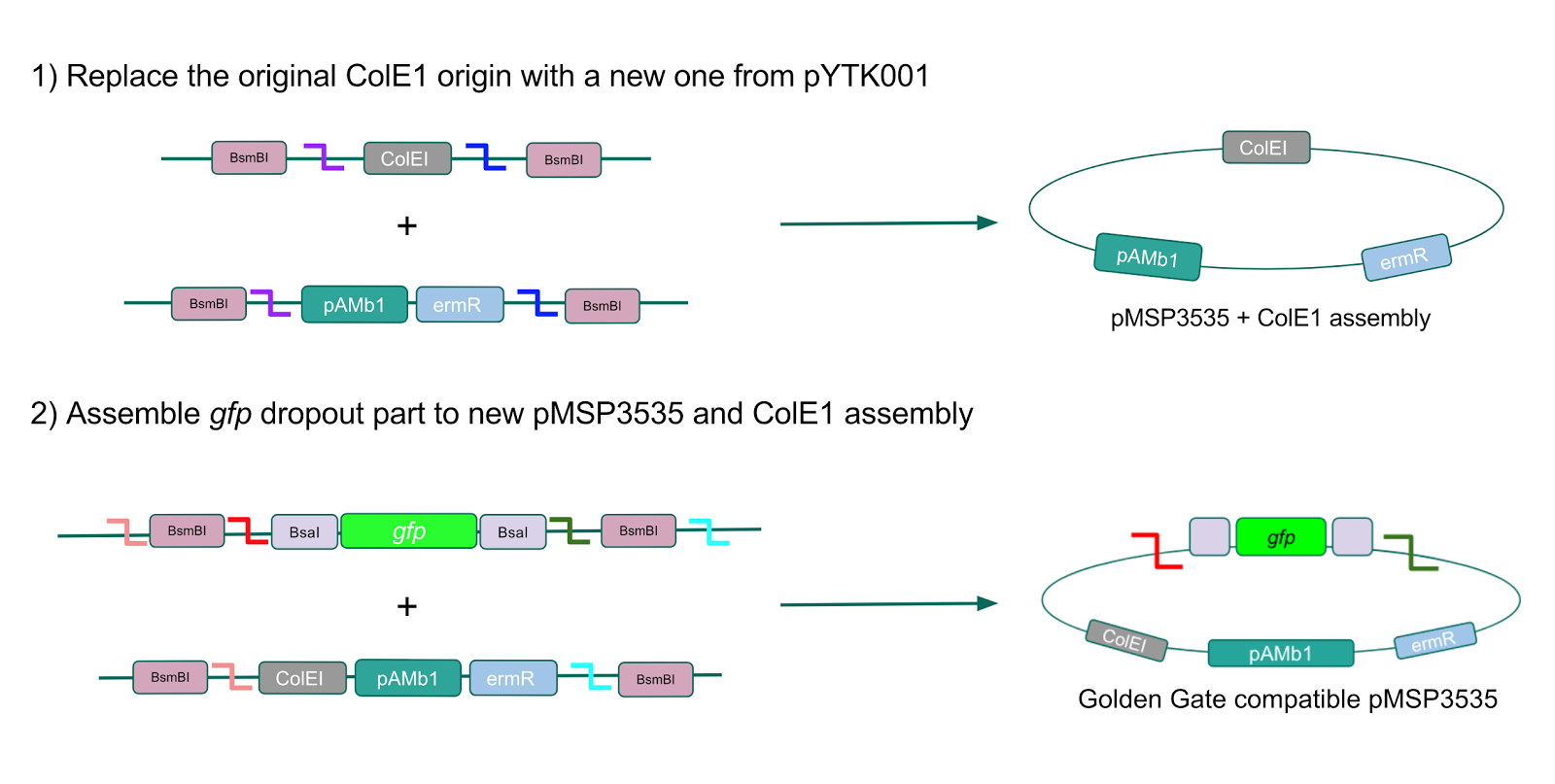
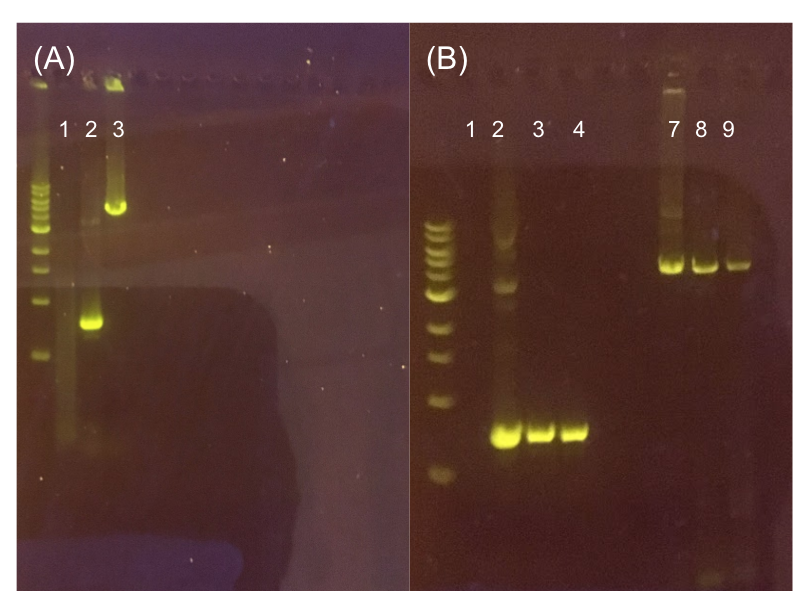
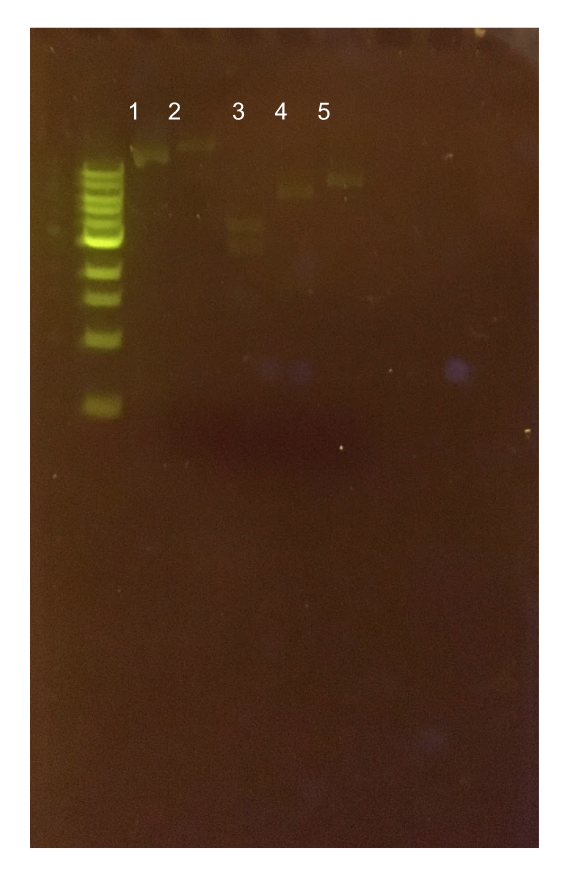
Assessing erythromycin susceptibility of E. coli
Because we are creating our Golden Gate compatible pMSP3535 shuttle vector in E. coli, we wanted to determine the natural susceptibility of E. coli to erythromycin as the minimum concentration to use has not been established clearly in the literature. Thus, we performed an erythromycin minimum inhibitory concentration test in liquid LB media (Fig. 13). After one-day incubation, we observed that E. coli was resistant up to around 150 µg/mL of erythromycin. From this experiment, we have determined that the optimal erythromycin concentration for selecting against E. coli in liquid culture is around 200-250 µg/mL.





